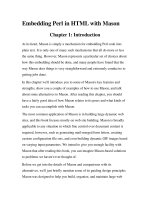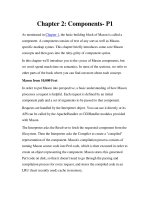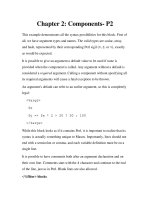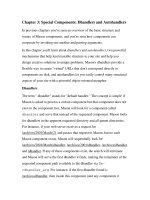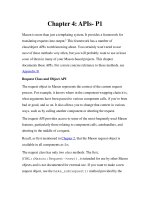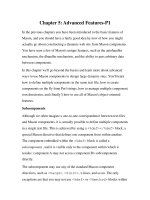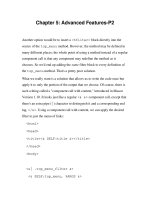Tài liệu Embedding Perl in HTML with Mason Chapter 5: Advanced Features-P2 pdf
Bạn đang xem bản rút gọn của tài liệu. Xem và tải ngay bản đầy đủ của tài liệu tại đây (38.91 KB, 19 trang )
Chapter 5: Advanced Features-P2
Another option would be to insert a <%filter> block directly into the
source of the top_menu method. However, the method may be defined in
many different places; the whole point of using a method instead of a regular
component call is that any component may redefine the method as it
chooses. So we'd end up adding the same filter block to every definition of
the top_menu method. That's a pretty poor solution.
What we really want is a solution that allows us to write the code once but
apply it to only the portion of the output that we choose. Of course, there is
such a thing called a "component call with content," introduced in Mason
Version 1.10. It looks just like a regular <& &> component call, except that
there's an extra pipe (|) character to distinguish it and a corresponding end
tag, </&>. Using a component call with content, we can apply the desired
filter to just the menu of links:
<html>
<head>
<title><& SELF:title &></title>
</head>
<body>
<&| .top_menu_filter &>
<& SELF:top_menu, %ARGS &>
</&>
% $m->call_next;
</body>
</html>
So the .top_menu_filter component -- presumably a subcomponent
defined in the same file -- is somehow being passed the output from the call
to <& SELF:top_menu,%ARGS &>. The .top_menu_filter
component would look something like this:
<%def .top_menu_filter>
% my $text = $m->content;
% my $uri = $r->uri;
% $text =~ s,<a
href="\Q$uri\E[^"]*">([^<]+)</a>,<b>$1</b>,;
<% $text %>
</%def>
This looks more or less like any other <%filter> block, but with two
main differences. First, the body of a <%filter> block contains plain Perl
code, but since .top_menu_filter is a subcomponent, it contains
Mason code. Second, we access the text to filter via a call to $m-
>content instead of in the $_ variable. The $m->content() method
returns the evaluated output of the content block, which in this case is the
output of the SELF:top_menu component.
Mason goes through some contortions in order to trick the wrapped portion
of the component into thinking that it is still in the original component. If we
had a component named bob.html
, as shown in the example below:
<&| .uc &>
I am in <% $m->current_comp->name %>
</&>
<%def .uc>
<% uc $m->content %>
</%def>
we would expect the output to be:
I AM IN BOB.HTML
And indeed, that is what will happen. You can also nest these sorts of calls:
<&| .ucfirst &>
<&| .reverse &>
I am in <% $m->current_comp->name %>
</&>
</&>
<%def .reverse>
<% scalar reverse $m->content %>
</%def>
<%def .ucfirst>
<% join ' ', map {ucfirst} split / /, $m->content
%>
</%def>
This produces:
Lmth.bob Ni Ma I
As you can see, the filtering components are called from innermost to
outermost.
It may have already occurred to you, but this can actually be used to
implement something in Mason that looks a lot like Java Server Page taglibs.
Without commenting on whether the taglib concept is conducive to effective
site management or not, we'll show you how to create a similar effect in
Mason. Here's a simple SQL select expressed in something like a taglib
style:
<table>
<tr>
<th>Name</th>
<th>Age</th>
</tr>
<&| /sql/select, query => 'SELECT name, age FROM
User' &>
<tr>
<td>%name</td>
<td>%age</td>
</tr>
</&>
</table>
The idea is that the query argument specifies the SQL query to run, and the
content block dictates how each row returned should be displayed. Fields are
indicated here by a % and then the name of the field.
Now let's write the /sql/select
component.
<%args>
$query
</%args>
<%init>
my $sth = $dbh->prepare($query);
while ( my $row = $sth->fetchrow_hashref ) {
my $content = $m->content;
$content =~ s/%(\w+)/$row->{$1}/g;
$m->print($content);
}
</%init>
Obviously, this example is grossly simplified (it doesn't handle things like
bound SQL variables, and it doesn't handle extra embedded % characters
very well), but it demonstrates the basic technique.
Seeing all this, you may wonder if you can somehow use this feature to
implement control structures, again a taglib-esque idea. The answer is yes,
with some caveats. We say "with caveats" because due to the way this
feature is implemented, with closures, you have to jump through a few
hoops. Here is something that will not work:
<&| /loop, items => ['one', 'two', 'three'] &>
<% $item %>
</&>
And in /loop
:
<%args>
@items
</%args>
% foreach my $item (@items) {
<% $m->content %>
% }
Remember, the previous example will not work. The reason should be
obvious. At no time is the variable $item declared in the calling
component, either as a global or lexical variable, so a syntax error will occur
when the component is compiled.
So how can this idea be made to work? Here is one way. Rewrite the calling
component first:
% my $item;
<&| /loop, items => ['one', 'two', 'three'], item
=> \$item &>
<% $item %>
</&>
Then rewrite /loop
:
<%args>
$item
@items
</%args>
% foreach (@items) {
% $$item = $_;
<% $m->content %>
% }
This takes advantages of how Perl treats lexical variables inside closures, but
explaining this in detail is way beyond the scope of this book.
You can also achieve this same thing with a global variable. This next
version assumes that $item has been declared using allow_globals:
<&| /loop, items => ['one', 'two', 'three'] &>
<% $item %>


